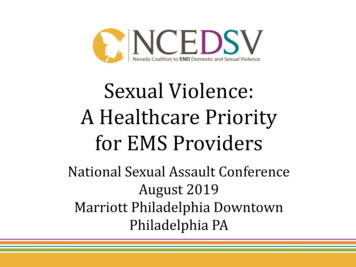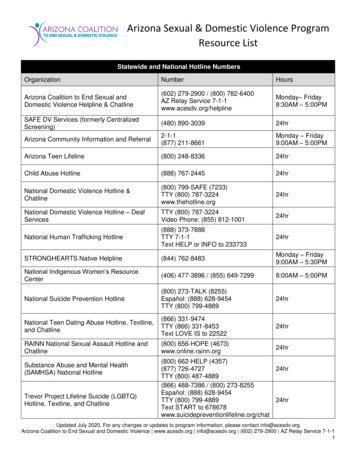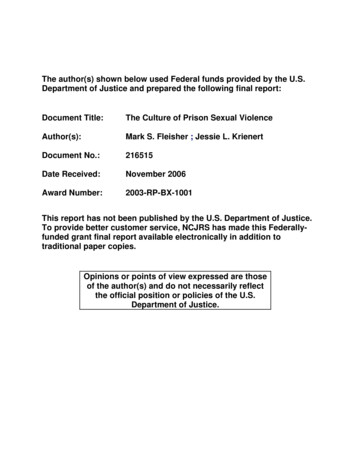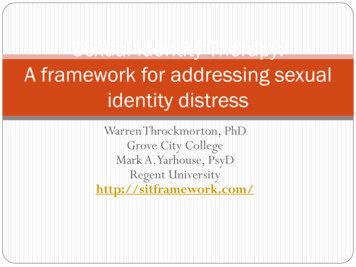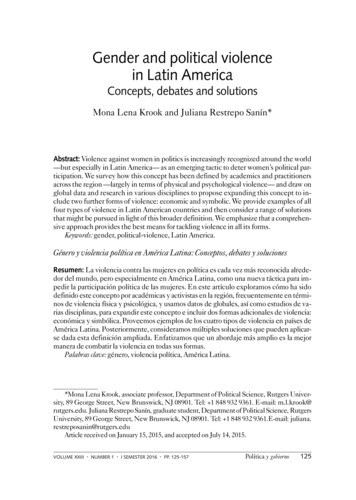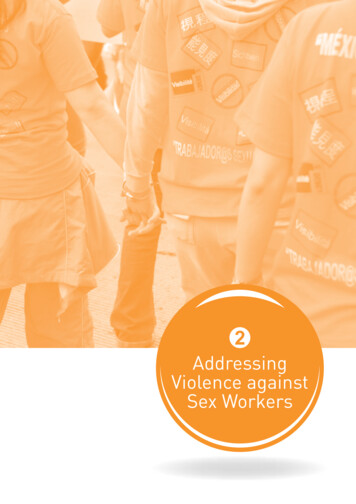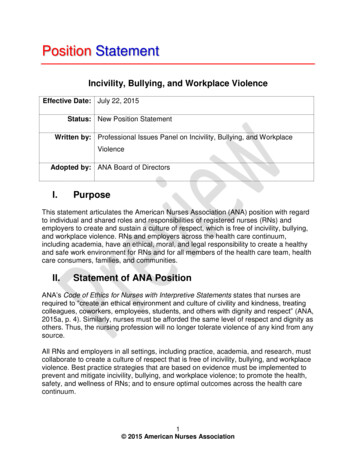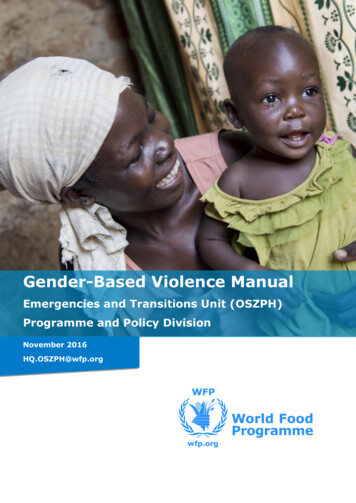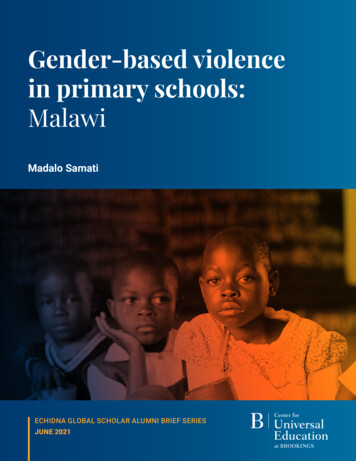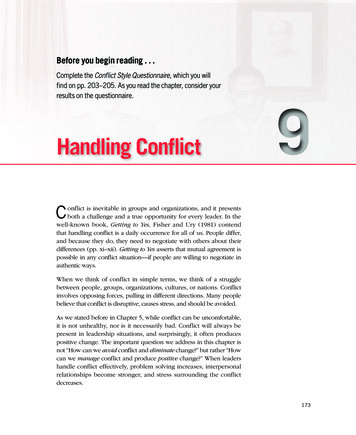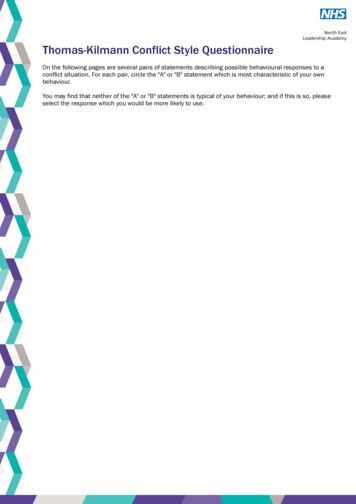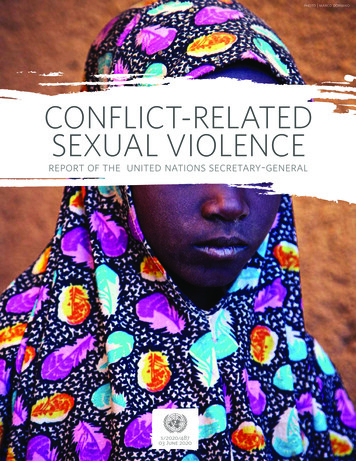
Transcription
photo marco dorminoCONFLICT-RELATEDSEXUALVIOLENCEreport of the united nations secretary-generals/2020/48703 June 2020
I.un photo/mark gartenINTRODUCTION“conflict-related sexual violence is now widely recognized as awar crime that is preventable and punishable. the united nationssecurity council has played an important role in the past decadeby passing successive resolutions that emphasize accountabilityfor perpetrators and services for survivors.”- united nations secretary-general antónio guterres21.The present report, which covers the periodfrom January to December 2019, is submitted pursuantto Security Council resolution 2467 (2019), in whichthe Council requested me to report on theimplementation of resolutions 1820 (2008), 1888(2009), 1960 (2010) and 2106 (2013).2.In April 2019, through the adoption ofresolution 2467 (2019), the Security Councilrecognized the need for a survivor-centred approachto inform all measures to prevent and address sexualviolence in conflict and post-conflict situations. On 30October, the Office of my Special Representative onSexual Violence in Conflict marked the 10-yearanniversary of the mandate through a survivors’hearing and the launch of a Global Survivors Fundspearheaded by the Nobel Laureates, Denis Mukwegeand Nadia Murad. The event represented a milestoneand provided an opportunity to take stock of thesignificant normative, institutional and operationalprogress achieved, and to set the stage for a newdecade of decisive action, with a focus on empoweringsurvivors and fostering compliance with existingcommitments.3.The year 2020 is also pivotal for the womenand peace and security agenda. In addition to markingthe twentieth anniversary of the adoption of resolution1325 (2000), and the twenty-fifth anniversary of theadoption of the visionary Beijing Declaration andPlatform for Action (1995), it will also mark 75 yearssince the establishment of the United Nations itself,with its founding promise of gender equality enshrinedin the Charter of the United Nations (1945). Despiteimportant progress on the policy and operationalfronts, we face an increasingly complex global securityenvironment in which sexual violence remains a crueltactic of war, torture, terror and political repression,and a brutally effective tool of displacement anddehumanization. We have yet to adequately invest intackling the structural root causes that drive andperpetuate this violence, including gender inequality,which is exacerbated by conflict and militarization. Asurvivor-centred, rights-based response aims to createa safe and participatory environment, includingthrough contextualized solutions that build resilienceand address the diverse experiences of all survivors.This approach is critical to ensuring that no one is leftbehind or excluded from the dividends of peace anddevelopment.4.The term “conflict-related sexual violence”, asused in the present report, refers to rape, sexualslavery, forced prostitution, forced pregnancy, forcedabortion, enforced sterilization, forced marriage, andany other form of sexual violence of comparablegravity perpetrated against women, men, girls or boysthat is directly or indirectly linked to a conflict. This linkmay be evident in the profile of the perpetrator, who isoften affiliated with a State or non-State armed group,which includes terrorist entities or networks; theprofile of the victim, who is frequently an actual orperceived member of a persecuted political, ethnic orreligious minority, or targeted on the basis of actual orperceived sexual orientation or gender identity; theclimate of impunity, which is generally associated withState collapse; cross-border consequences, such asdisplacement or trafficking; and/or violations of theprovisions of a ceasefire agreement. The term alsoencompasses trafficking in persons for the purpose ofsexual violence and/or exploitation, when committedin situations of conflict.5.While many countries are affected by thethreat, occurrence or legacy of conflict-related sexualviolence, the present report is focused on 19 countriesfor which information verified by the United Nationsexists. It should be read in conjunction with my 10previous reports, which provide a cumulative basis forthe listing of 54 parties (see annex). The majority oflisted parties are non-State actors, with several havingbeen designated as terrorist groups according to theISIL (Da’esh) and Al-Qaida sanctions list. Nationalmilitary and police forces that are listed are required toadopt specific, time-bound commitments and actionplans to address violations and are prohibited fromparticipating in United Nations peace operations.Effective implementation of commitments, includingthe cessation of violations, is a key consideration forthe delisting of parties. Non-State armed groups arealso required to implement action plans to prevent andaddress sexual violence.3
47.Strengthening the capacity of national rule oflaw institutions is critical in order to advance credible andinclusive accountability processes for past crimes, as wellas for prevention and deterrence of future crimes. In thisregard, the Team of Experts on the Rule of Law and SexualViolence in Conflict, in accordance with its mandateunder Security Council resolution 1888 (2009) continuesto convene, coordinate and collaborate with UnitedNations system entities so as to assist national authoritiesin strengthening institutional safeguards against impunity,as part of broader efforts to reinforce the rule of law. Sinceits establishment, the Team of Experts has engaged in theCentral African Republic, Colombia, Côte d’Ivoire, theDemocratic Republic of the Congo, Guinea, Iraq, Liberia,Mali, Myanmar, Nigeria, Somalia, South Sudan and theSudan, in follow-up to the high-level political engagementsof my Special Representative and with the consent ofMember States. In 2019, the Team of Experts contributedto addressing impunity and supporting victims,complementing the efforts of United Nations systementities through the Global Focal Point for the Rule of Law.In the Central African Republic, the Team of Expertscontinued to assist the national authorities, including thejoint rapid response and prevention unit for addressingsexual violence against women and children, to increasetheir capacity to investigate and prosecute conflictrelated sexual violence. The United Nations alsosupported a dedicated criminal court session in Banguion sexual and gender-based violence. In easternDemocratic Republic of the Congo, the Team of Expertscontinued to provide technical assistance to Congolesejudicial authorities, and in Guinea, as a full member of thesteering committee established by the Government toorganize trials for the crimes of 28 September 2009, inwhich at least 156 people were killed or disappeared andat least 109 women and girls were victims of sexualviolence (see A/74/139), the Team continued to supportnational efforts, including through the deployment of adedicated senior judicial adviser. In Nigeria, the Team ofExperts collaborated with the United Nations Office onDrugs and Crime and international non-governmentalorganizations to support training for members of thenational judiciary, including the specialized unit workingon Boko Haram-related cases. In South Sudan, the Teamof Experts facilitated the adoption by the South SudanNational Police Service of its action plan on addressingconflict-related sexual violence.8.The United Nations Action against SexualViolence in Conflict network, which comprises 14 entities,is dedicated to amplifying advocacy, improvingcoordination and accountability, and supporting countryefforts to prevent conflict-related sexual violence andrespond effectively to the needs of survivors, inaccordance with the priorities articulated by the networkand its Chair, my Special Representative. In 2019, thenetwork was reinforced through the addition of a newmember, the Office for Disarmament Affairs, and ninenew projects were launched. In Myanmar, one projectwas aimed at enhancing accountability for conflictrelated sexual violence, and another at promoting genderequality and women’s empowerment in the context ofpreventing human trafficking. In South Sudan, the networkfinanced the scaling up of a one-stop centre for survivorsand a project to build the capacity of the justice andsecurity sector. The network further supported twoprojects in Iraq aimed at strengthening psychosocialservices and establishing mechanisms for reparations. Inaddition, it supported the finalization of the nationalstrategy on preventing and eliminating gender-basedviolence in the Central African Republic and continued tosupport the Gender-based Violence InformationManagement System. At the global level, the InternationalOrganization for Migration and the Office of my SpecialRepresentative organized a workshop on reparations,which focused on ensuring complementarity betweennational and international efforts to improve access toremedies for survivors. The network also initiated amapping exercise to identify and fill gaps in guidance andoperational tools, as requested by the Security Council inits resolution 2467 (2019). The network also worked inSomalia, which resulted in support for a joint project forwomen and girls formerly associated with Al-Shabaab, aswell as providing technical assistance in the DemocraticRepublic of the Congo and Myanmar.9.While acknowledging that conflict-relatedsexual violence committed by parties to conflict is distinctfrom incidents of sexual exploitation and abuse thatcontinue to be committed by United Nations personnel incomplex operating environments, I reiterate mycommitment to improve the way the Organizationprevents and addresses such conduct. In my report onspecial measures for protection from sexual exploitationand abuse (A/73/744), I provided information on effortsto strengthen the system-wide response and ensure fullimplementation of the zero-tolerance policy.photo un women m r hasan6.The increased presence of women’s protectionadvisers, who are responsible for convening themonitoring, analysis and reporting arrangements onconflict-related sexual violence in the field, has improvedthe availability and quality of information. At the time ofwriting, women’s protection advisers are deployed inseven United Nations peace operations. All peacekeepingmissions with mandates that include the protection ofcivilians have established monitoring arrangements andincorporated the matrix of early warning indicators ofconflict-related sexual violence into their broaderprotection structures. The special political missions inIraq and Somalia have also established such arrangements.II.Sexual Violence as a Tactic of War andTerrorism: Patterns, Trends and EmergingConcerns10.The past decade has seen a paradigm shift inglobal understanding of the impacts of the atrocity ofconflict-related sexual violence, particularly in terms ofits relevance to international peace and security, themultisectoral services needed by survivors, theimperative need for gender-responsive security sectorreform, and the necessity of tackling gender inequalityas a root cause in times of war or conflict, and in times ofpeace. While the silence has been broken, and the issuehas galvanized global attention on conflict-related sexualviolence as an obstacle to peacebuilding and recovery,we must never allow these atrocities to persist withimpunity, to become entrenched and “normalized” inpost-conflict societies. The international communitymust never lose sight of the profound human suffering atthe heart of this agenda. Accordingly, a range ofexperiences and the views and perspectives of survivors,which illustrate critical trends and emerging concerns,are presented in paragraphs 17 to 62 below, and shouldbe read while bearing in mind that there are countlessother stories that will never be heard. Most survivorsface insurmountable social, structural and securitybarriers, including stigma, the repercussions of whichare potentially deadly, and such barriers prevent theircases from being counted, addressed or reflected in thehistorical record. The present report is limited toincidents verified by the United Nations and does notpurport to capture the prevalence of cases. While itcannot reflect the scale of these crimes, it serves toconvey their severity.11.In the Central African Republic, a mother of sixwas subjected to sexual violence by ex-Séléka elementswho seized control of her village. During a reprisal attackby anti-balaka forces, she was abducted and repeatedlyraped. Eventually, she escaped from captivity and walkedmore than 130 kilometres on foot before finding safety ina United Nations Multidimensional IntegratedStabilization Mission in the Central African Republic(MINUSCA) base. The United Nations transferred her to5
Bangui for medical care, and then to a local non-governmentalorganization for psychosocial support and literacy training.This survivor now works on behalf of other survivors of sexualviolence, conducting outreach and referrals. Her exceptionaljourney from victim to activist shows what is possible whentimely and appropriate support is available. Indeed, in recentyears, there has been a positive trend with respect to anincreasing number of survivors becoming mobilized asadvocates and champions and politically engaged in thepursuit of peace. Yet, in the contexts covered in the presentreport, humanitarian services for survivors of sexual andgender-based violence remain chronically underfunded, andmany struggle simply to meet their basic needs in theaftermath of these atrocities. Funding shortfalls for theprogrammatic response, including sexual and reproductivehealth care, result in major gaps in the reach and coverage oflife-saving, and potentially life-changing, interventions.12.In northern Mali, two sisters of adolescent age wereabducted and gang raped by members of the Mouvementnational de libération de l’Azawad. Upon their release, thegirls received medical treatment, but no complaint was filedwith the police, despite the identity of the perpetrators beingknown to the family, owing to the fear of reprisals. In suchcases, impunity remains the rule and accountability the rareexception, which emboldens perpetrators and perpetuatesvicious cycles of abuse. This case is illustrative of the fact thatacross a range of settings examined in the present report thataccess to justice continues to be constrained by a number offactors, including stigma, the absence of protective measuresfor victims and witnesses, the limited availability of legal aid,limited awareness of avenues for redress, and the weaknessof local institutions. In some cases, security sector actors arethemselves complicit in the crimes and/or the intimidation ofvictims and witnesses. Women and girls face dauntinggender-based barriers to justice, which are associated withsocial, cultural and economic disempowerment. At the globallevel, there remains a glaring discrepancy between thedocumentation of crimes, which is extensive, and theiradjudication, which remains elusive.13.The issue of reparations for crimes of conflictrelated sexual violence has acquired increased prominence inglobal discourse over the past year, against the backdrop ofdecades of related efforts in the field of transitional justice.Attempts to pursue the provision of assistance andreparations in practice will require innovative approaches toensure sustainable funding, including private sectorpartnerships, to provide assistance to victims in contextswhere a reparations gap exists. Closing the gap can helpsurvivors to rebuild their lives and livelihoods, as well asrestore confidence in national institutions. Yet, reparationsremain the justice intervention that survivors seek the mostbut receive the least. In several contexts covered herein, theslow pace of justice and the absence of reparations have led6to increased recourse to traditional and/or customary courts,which tend to resolve cases of rape through the awarding ofmaterial assistance to the family of the victim. While such anapproach can temporarily alleviate economic hardship, theyachieve little in terms of punishing and deterring perpetrators,or with respect to upholding women’s rights. Some promisingdevelopments in this context include: (a) the judgment in thecase of Alimasi Frederic, alias “Kokodikoko” in the DemocraticRepublic of the Congo, which found the State liable forreparations for failing to protect civilians from sexual violenceby militias; (b) the delivery of compensation to over one thirdof registered victims of conflict-related sexual violence inColombia; and (c) efforts in Iraq to develop a reparations lawand relief programme for survivors of conflict-related sexualviolence, with initial grants disbursed in 2019. In contextssuch as the Western Balkans, victims of wartime sexualviolence have been belatedly recognized as legitimate warvictims, an official status that renders them eligible forreparations. However, in other settings, such as Nepal, fewsurvivors of sexual violence have come forward to claimreparations, owing to the onerous legal and administrativethresholds.14.In Tanganyika Province in the Democratic Republicof the Congo, a young man was stripped naked, raped andforced to rape his own mother during a Twa militia attack onhis village. It took him many months to overcome theprofound sense of shame and the fear of stigmatization andreprisals, in order to seek support. The use of sexual violenceto shred the social fabric and fracture families, includingthrough the violation of cultural taboos, continues to beparticularly evident in the context of ethnic and intercommunalconflicts. The rape of men and boys has been used to attacktheir socially constructed identity as “protectors”, and toinflict humiliation, given prevailing stereotypes aboutmasculine invulnerability. The risks and repercussions ofconflict-related sexual violence are linked with identity-basedvulnerabilities, which are multiple and intersecting. Duringthe reporting period, women and girls continued to accountfor the vast majority of recorded victims, placed at elevatedrisk by structural gender-based discrimination in political,economic and social life. Men and boys continued to suffersexual violence in detention in several settings. Individualswere also targeted on the basis of their actual or perceivedsexual orientation and gender identity as a form ofpersecution. Refugees and migrants faced heightened risks ofsexual violence during flight and in displacement settings,leading to increased recourse to negative coping mechanisms,such as early and forced marriage, and the withdrawal ofwomen and girls from employment and education, asobserved in Iraq, the Syrian Arab Republic and Yemen andamong the displaced Rohingya community in Bangladesh.Indigenous women have been targeted primarily in thecontext of conflicts over ancestral land and natural resources,as seen during the conflict periods in Colombia andGuatemala. Persons living with disabilities have also beensexually abused, including following separation from theircaregivers in the chaos of war, as documented in the SyrianArab Republic. The trauma of sexual violence echoesacross generations, affecting in particular children born ofwartime rape, who often experience a lack of identity andbelonging in highly polarized societies. The plight andrights of children born of war need to be further examined,including the question of whether these children areparticularly susceptible to recruitment, radicalization andtrafficking, and what can be done to support their socialintegration. A survivor-centred approach, as articulated bythe Security Council in a resolution for the first time in 2019(resolution 2467 (2019)), requires the recognition thatsurvivors are not a homogenous group, but sufferdifferentiated harms based on intersecting inequalities,which can compound over time in the absence of a tailoredresponse. It further recognizes that the specific rights,needs and aspirations of survivors must be prioritized in allpolicies, programmes and operations.15.A survivor-centred approach must also informprevention and early warning efforts, as conflict-relatedsexual violence is often preceded by discrimination,persecution, hate speech and incitement based on genderand group identity, as seen in Burundi, Myanmar, SouthSudan and elsewhere. Gender-based hate speech andharassment, compounded by restricted civic space, asoutlined in my Strategy and Plan of Action on Hate Speech,has resulted in a negative trend of attacks and reprisalsagainst women human rights defenders, including as partof political and electoral repression. In the absence ofeffective security guarantees, the past year has seen manywomen retreat from prominent leadership roles in thepeace and transitional justice process, for example inColombia, following threats and attacks against themselvesand their families. Nevertheless, there has been anunprecedented level of engagement by religious leadersfrom across the spectrum of faiths in recent years to helptransform harmful social norms, including by imams inMali, Yazidi and Sunni leaders in Iraq, the South SudanCouncil of Churches, and the Interreligious Council inBosnia and Herzegovina, all of which have condemnedsexual violence and called for efforts to alleviate the sociallycorrosive effects of stigma. By using their moral authority,religious leaders could significantly contribute to addressingthe root causes of these crimes, such as entrenched genderinequality and related codes of honour and shame. Suchengagement is of particular importance in the context ofIslamic State in Iraq and the Levant (ISIL), as women andchildren formerly associated with violent extremist andterrorist groups are viewed primarily as “affiliates” ratherthan victims. In the words of one survivor of sexual slavery,from Sinjar, Iraq: “I was just 14 when I was kidnapped byISIL. I was separated from my family. ISIL took us prisonerand tortured us for three long years. They are the criminals,but we continue to suffer, and they are not held accountable.”Given the repressive patriarchal ideology of many armedgroups, built on controlling women’s sexuality andreproduction as part of self-perpetuation strategies, sexualviolence has been recognized as a form of extremistviolence and a tactic of terrorism. Yet counter-terrorismtrials that are under way in Iraq, Mali and Nigeria do nottake sexual violence offences into account. Moreover,patterns of gender-based repression and sexual violencepersist in areas affected by the Boko Haram insurgency,including across borders, as a factor driving displacementand linked with trafficking for the purposes of sexualexploitation, which generates profits for armed and criminalgroups. A regional response to such trafficking is required,involving intergovernmental cooperation and informationsharing in the Lake Chad basin and the Sahel.16.As a survivor of wartime sexual violence fromGuatemala told the United Nations in 2019: “We do notwant history to repeat. We are working for peace andjustice so that our children and grandchildren will neverknow this suffering.” Indeed, sexual violence is linked withbroader trends related to peacebuilding and social justice.The present report finds that patterns of conflict-relatedsexual violence do not occur in a vacuum, but directlycorrelate with factors such as the resurgence of hostilities,militarization, the proliferation of small arms and lightweapons, mass population displacement, the rise of violentextremism, the collapsed rule of law and the proximity ofarms bearers to civilian populations. Successive reportsover the past decade indicate that conflict-related sexualviolence is concentrated in contexts of detention, captivity,displacement and in rural and remote locations wherewomen undertake essential livelihood activities. These arealso the contexts most affected by humanitarian accessrestrictions and poor service coverage. Despite theadoption of numerous commitments to address conflictrelated sexual violence, broader political, economic andsecurity factors inhibit enforcement, preventing linearprogress from commitments to compliance. Accordingly,the end goal of conflict-related sexual violence agenda isnot a “war without rape”, but rather a world without war.As witnessed in the Sudan and elsewhere in 2019, womenare powerful agents of change. They are not just victims ofwar, but vectors of peace and progress. Women’sparticipation in peace processes has been proven toenhance their sustainability, and yet it remains a challengeto secure their involvement and to ensure that the issuesdisproportionately and structurally affecting women areduly addressed. At the dawn of a new decade of action onthis mandate, we must harness the transformative powerof women’s leadership, and of amplifying the perspectivesand experiences of survivors, in order to move fromresolutions to results.7
III.Sexual violence in conflict-affectedsettingsAfghanistan18.The Government continued its efforts toharmonize domestic laws and policies with internationalstandards, promulgating a Law on Protection of ChildRights, and a policy for the protection of women in warand emergency situations, as well as reviewing the Lawon Elimination of Violence against Women and approvingdraft regulations on emergency funds for victims. Familyprotection centres and women-friendly spaces exist inseveral provinces to provide holistic assistance tosurvivors of sexual violence. In August, the Governmentlaunched its second national action plan on theimplementation of Security Council resolution 1325(2000), with support from the United Nations. In remoteareas, where State authority is limited, the use of localconflict resolution mechanisms to address sexual violencehas resulted in some survivors being compelled to marrythe perpetrator or face retaliation.8Recommendation19. I commend the Government’sefforts to put in place a moreprotective legal and policy frameworkfor women, girls and boys at risk, andurge the full implementation thereof,with particular attention being givento rural and remote communities andto combating impunity forperpetrators of sexual violence. Ireiterate the importance of aninclusive Afghan-led peace processwith the meaningful participation ofwomen, young people and minoritiesand call for the creation of the spacesfor women to actively participate inall levels of decision-making so as tosolidify gains made and enhancewomen’s rights.unama photo fraidoon poya17.The underreporting of sexual violence remains aconcern in Afghanistan, stemming from an overallsituation of gender-based inequality, discriminatory socialnorms and stigmatization, which prevent women and girlsfrom accessing information or services. This is exacerbatedby a climate of impunity, widespread violence and limitedaccess to areas under the control of armed groups. In2019, the United Nations Assistance Mission inAfghanistan (UNAMA) documented 102 cases of sexualviolence, 27 of which were able to be verified as conflictrelated, affecting 7 women, 7 girls and 13 boys. Thoseincidents were attributed to members of the Taliban. TheAfghan National Defence and Security Forces and a progovernment militia were also implicated. Two of theseincidents were documented as bacha bazi, a practiceinvolving the sexual abuse of boys by men in positions ofpower. Eight cases were transferred to the national judicialsystem, resulting in four convictions. The United Nationsreceived further information of 18 credible allegations ofconflict-related sexual violence, which could not beverified owing to safety concerns.9
Central African Republicun minusca leonel grothecommitted by more than one perpetrator. Moreover, asthe number of displaced persons increased, 2019 alsosaw a marked increase in the level of sexual violenceoccurring in internal displacement sites and hostcommunities, as well as in rural locations, in particularwhile women and girls were fleeing attacks, or in thecourse of collecting firewood and food.20.The Political Agreement for Peace andReconciliation (S/2019/145, annex), signed between theGovernment and 14 armed groups in February 2019, callsfor the cessation of all forms of sexual and gender-basedviolence (article 5). However, signatories continue toflagrantly use sexual violence as a tactic of terror againstcivilians. Many challenges remain with respect tomonitoring, owing to access constraints, attacks byarmed groups against humanitarians and large-scaledisplacement. In 2019, MINUSCA verified 322 incidentsof conflict-related sexual violence, affecting 187 women,10124 girls, 3 men, 2 boys and 6 females of unknown age.These incidents included 174 rapes or attempted rapesand 15 cases of forced marriage. In terms of the profile ofthe perpetrators, 83 cases were attributed to ex Sélékagroups, 48 to Fulanis, who may have been affiliated withex-Séléka, 47 to anti-balaka, 19 to Retour, réclamation etréhabilitation, 2 to the Lord’s Resistance Army, 1 tocriminal gangs, and several to unidentified perpetrators.A total of seven verified cases were attributed to theArmed Forces of the Central African Republic. Reportsindicate that 60 per cent of these incidents were21.In Basse-Kotto prefecture, women and girlswere systematically abducted by anti-balaka elements,who sexually abused the victims before selling them.The Government responded by designating the Ministerfor the Promotion of Women, Family and Child Protectionas focal point to tackle trafficking in persons. In Mbomouprefecture in the east, which remains largely inaccessibleowing to the absence of roads, the Front populaire pourla renaissance de la Centrafrique and Union pour la paixen Centrafrique continue to perpetrate sexual violence,leading to mass displacement. The fear of reprisals,stigmatization, the lack of services and widespreadimpunity prevent victims from reporting these crimesand receiving ass
2 3 I N T R O D U C T I O N 1. The present report, which covers the period from January to December 2019, is submitted purs
